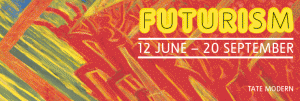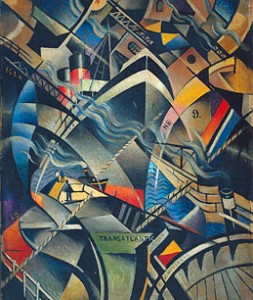Tate Modern marks Futurism centenary with new show
More:
Video via Times UK Online
Tate Modern show brings pivotal Futurist art works together for first time
By Josie Cox
LONDON (Reuters) – “Art … can be nothing but violence, cruelty, and injustice” declared the founding fathers of Futurism, the avant-garde movement formed 100 years ago and celebrated at a major show in London opening this week.
The exhibition at Tate Modern opens with the 1909 manifesto by Italian poet Filippo Marinetti, which set out Futurism’s ambition to sweep away the old and usher in a new dawn in art celebrating the dynamism of modern urban life.
The show also examines the battle of the “isms” in Europe in the early 20th century, with leading painters and writers passionately defending their own particular movement, from Futurism to Vorticism, and Cubism to Orphism.
“Futurism,” which runs from June 12 to September 20, showcases the work of artists like Giacomo Balla and Gino Severini, but also more famous names like Pablo Picasso.
Many pieces in the collection depict city life as a constant and simultaneous flow of events and experiences.
Telegraph poles, fast trains and industrial buildings, some painted on huge canvases, reveal how the artists were obsessed with innovative urban development ahead of World War One.
“We fight against the nude in painting, as nauseous and as tedious as adultery in literature,” the manifesto states, adding that a picture must be a fusion of a subject’s psychology and its surroundings.
WHOSE MOVEMENT IS BEST?
Robert Delaunay’s 1913 painting of the Cardiff Rugby team, overshadowed by a colorful Ferris wheel, the Eiffel Tower and a billboard advertising an aircraft construction company, conveys the dynamism characteristic of the movement.
The painting, with merging and colliding lines and bold shapes and colors, was inspired by a newspaper advertisement and shows a rugby player as he jumps in the air for a ball.
It also underlines the fierce rivalry between artists and their movements.
When French poet Guillaume Apollinaire praised the work, Italian Futurist Umberto Boccioni said: “They are copying us while pretending to know nothing about us!”
Delaunay countered: “I am not and have never been a Futurist,” and accused the Italians of being “publicity hungry.”
Severini’s kaleidoscopic “The Dance of the ‘Pan-Pan’ at the Monico” mirrors the artist’s intention to provoke a reaction from conservative art critics used to the more austere Cubism, also popular at the time.
“Severini’s painting illustrates the excitement of the urban city and of new flirtatious interactions with strangers,” curator Matthew Gale said.
The painting depicts a scene from a Paris nightclub. Dancing ladies, onlookers and gaudy props create a direct contrast to more somber cubist pieces also on display, like Picasso’s 1910 “Woman in an Armchair” and Georges Braque’s 1911 “Still Life with Violin,” both predominantly grey and brown.
Visitors to the 11 exhibition rooms can admire art from London, Paris and Moscow, demonstrating how Futurism spread across the continent and influenced other 20th century movements like Dadaism, Art Deco and Constructivism.
(Editing by Mike Collett-White and Paul Casciato)


One Reply to “Futurism Opens at Tate Modern – June 12”